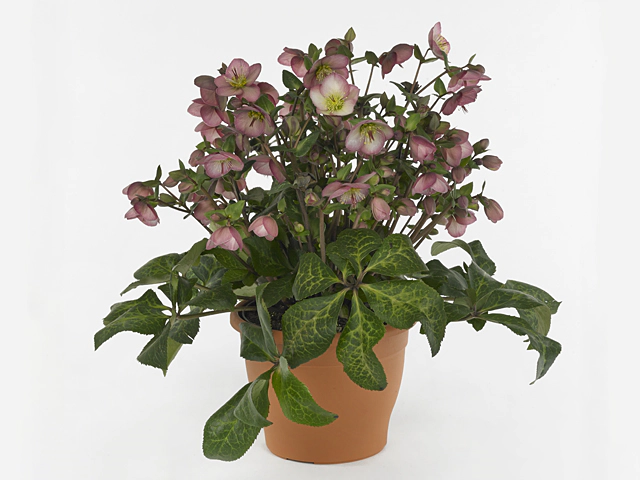Helleborus Sally's Shell

| Flower type | Single |
| Leaf margin | Serrate |
| Winter hardness | Reasonable (USDA-zone 7) |
| Flower color | Red-medium brown purple-186A |
| Flower diameter | 8 - 8,5 cm |
| Plant height | 30 - 40 cm; 40 - 50 cm |
| Flowering month(s) | January; February; March; December |
| Leaf size | 10 - 15 cm |
| soil pH requirement | Alkaline (pH > 7,5); Neutral (pH 6,5 - 7,5); Slightly acidic (pH 4,5 - 6,5) |
| Light conditions | Semi-shades |
| Leaf division | Palmate |
| Leaf, main color | Dark green |
| Leaf colour, pattern | Feathered |
| Flower color distribution | Unicolored with trace |
| Flower, secondary color(s) | Pink-medium blue pink-186D |
| Leaf, secondary color(s) | Light green |
| Moisture requirements | Well-drained; Moist |
| Soil type | Humus rich |
Introducing Helleborus Sally's Shell: A Stunning Addition to Your Garden
If you're looking to add a touch of elegance and beauty to your garden during the colder months, look no further than the Helleborus Sally's Shell. This exquisite flower is a sight to behold, with its single petals and mesmerizing color.
The Helleborus Sally's Shell is known for its serrated leaf margins, which add a unique texture to the plant. It is reasonably winter-hardy, making it suitable for USDA Zone 7 and other similar climates. This means that even in colder regions, you can still enjoy the beauty of this flower.
The flower itself has a captivating red-medium brown purple color. With a flower diameter of 8 to 8.5 cm, it is the perfect size to make a statement in your garden. The plant reaches a height of 30 to 40 cm, or alternatively 40 to 50 cm, giving you options depending on your preferences.
One of the most remarkable qualities of this flower is its extended blooming period. It starts to flower in January and continues through February, March, and even December. This means that during the gloomy winter months, you'll have a burst of color and life in your garden, thanks to the Helleborus Sally's Shell.
The leaves of this plant have a palmate division, adding to its distinct appearance. The main color of the leaves is a dark green, providing a beautiful contrast to the striking flower. Additionally, the leaf color pattern is feathered, further enhancing its overall appeal.
The flower color distribution of the Helleborus Sally's Shell is unicolored with a trace. While the primary flower color is a mesmerizing red-medium brown purple, there are also secondary colors present. These secondary colors include pink-medium blue pink, adding depth and diversity to the overall visual effect.
The secondary color of the leaves is light green, which complement the dark green main color, creating a harmonious and balanced look. This plant thrives in semi-shaded light conditions, making it ideal for areas in your garden that may not receive direct sunlight throughout the day.
When it comes to soil pH requirements, the Helleborus Sally's Shell can tolerate alkaline soil (pH greater than 7.5), neutral soil (pH 6.5 - 7.5), and slightly acidic soil (pH 4.5 - 6.5). This versatility makes it adaptable to a wide range of garden environments.
In terms of moisture requirements, this plant prefers well-drained soil but can also handle slightly moist conditions. Therefore, it's crucial to ensure that the soil is appropriately prepared to provide the best growing conditions for this flower.
Overall, the Helleborus Sally's Shell is a stunning addition to any garden. Its unique combination of beautiful flowers, distinctive leaves, and extended blooming period make it an excellent choice for those looking to add charm and elegance to their outdoor space. Its adaptability to various light and soil conditions also ensures that gardeners of all levels can enjoy its beauty. So, if you're ready to transform your garden, consider adding the Helleborus Sally's Shell to your collection.
Market availability index by month:
| Jan. | Feb. | Mar. | Apr. | May | Jun. | Jul. | Aug. | Sep. | Oct. | Nov. | Dec. |
|---|---|---|---|---|---|---|---|---|---|---|---|
| 3 | 2 | 1 | - | - | - | 1 | 1 | 1 | 3 | 4 | 3 |